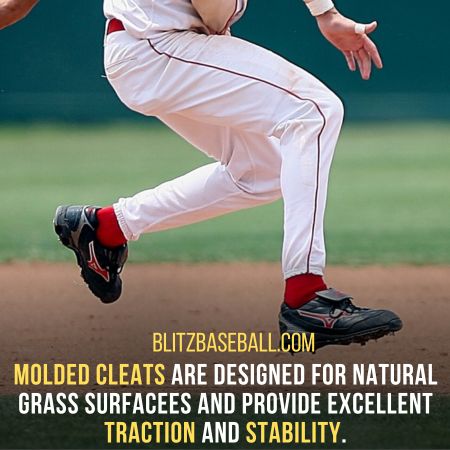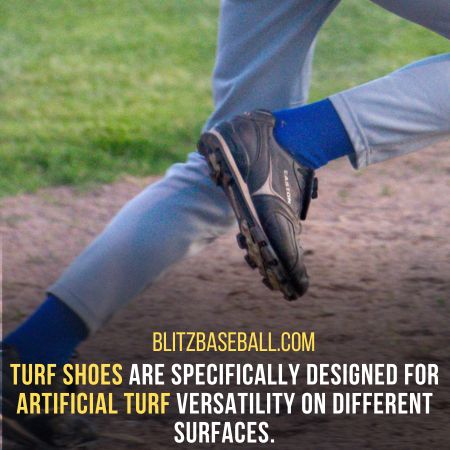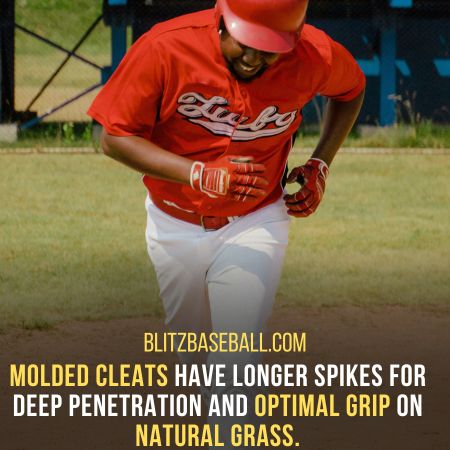This article aims to provide an objective comparison between molded cleats vs turf shoes, aiding readers in determining which type of footwear is most suitable for their needs.
Molded cleats are designed with plastic or metal spikes for use on natural grass or dirt surfaces.
Turf shoes, on the other hand, have rubber nubs or small studs for artificial turf.
By examining factors such as traction, durability, and surface usage, readers can make an informed decision to ensure safety and optimal performance.
Key Takeaways
- Molded cleats are designed for natural grass surfaces and provide excellent traction and stability.
- Turf shoes are specifically designed for artificial turf and offer improved traction and versatility on different surfaces.
- Molded cleats have longer spikes for deep penetration and optimal grip on natural grass.
- Turf shoes have shorter rubber nubs or studs that prevent excessive damage to the playing surface on artificial turf.
Molded Cleats: Definition and Purpose
Molded cleats are a type of athletic footwear designed with protruding rubber or plastic studs that provide traction on natural grass surfaces, making them suitable for sports such as soccer and baseball.
These cleats are typically made with a solid outsole that incorporates the studs, which are evenly distributed to ensure optimal grip and stability on the field.
The studs on molded cleats are non-removable, providing a more durable option compared to other cleat types like metal cleats. They offer excellent traction and support, allowing athletes to make quick cuts and changes in direction without sacrificing stability.
Molded cleats are also known for their versatility, as they can be used on various types of natural grass surfaces.
However, they may not provide the same level of traction on artificial turf or other hard surfaces, and using them on such surfaces can result in premature wear and damage to the studs.

Turf Shoes: Definition and Purpose
Turf shoes, specifically designed for artificial turf surfaces, offer athletes enhanced traction and stability. These shoes are equipped with small rubber nubs or studs on the outsole, which provide excellent grip on artificial turf.
The purpose of turf shoes is to prevent slippage and allow quick movements on the turf, reducing the risk of injury.
When comparing turf shoes to molded cleats, there are a few key differences to consider:
- Turf shoes have shorter, rubber nubs compared to the longer spikes on molded cleats. This design allows for better traction on artificial turf without causing damage to the surface.
- Turf shoes are generally more versatile and can be worn on different surfaces like grass, pavement, and gym floors, whereas molded cleats are primarily designed for natural grass fields.
Overall, turf shoes are a popular choice for athletes who frequently play on artificial turf surfaces, providing them with the necessary traction and stability needed for optimal performance.

Molded Cleats Vs Turf Shoes
When comparing the traction, durability, and surface usage of these two types of footwear, several factors come into play.
Molded cleats are designed with longer spikes that provide excellent traction on natural grass and dirt surfaces. The deep penetration of the spikes allows for enhanced grip and stability, making them ideal for sports such as soccer and baseball.
On the other hand, turf shoes feature rubber nubs or small, shallow studs that are specifically designed for artificial turf and indoor surfaces. They offer improved traction and prevent excessive damage to the playing surface.
In terms of durability, molded cleats tend to be more robust and long-lasting due to their construction with sturdy materials. However, the lifespan of both types of footwear can be influenced by factors such as frequency of use and maintenance.
It is important to note that wearing these shoes on hard surfaces can cause damage to the spikes on molded cleats and the rubber nubs on turf shoes. To ensure optimal safety and surface protection, it is recommended to strictly adhere to the recommended surfaces for each type of footwear.

Frequently Asked Questions
Are molded cleats or turf shoes more suitable for indoor use?
Both molded cleats and turf shoes are not recommended for indoor use. They are designed for outdoor fields and may not provide adequate traction on indoor surfaces. It is best to wear appropriate indoor athletic shoes for optimal performance and safety.
Can you wear molded cleats or turf shoes on grassy surfaces?
Molded cleats and turf shoes are suitable for grassy surfaces. Molded cleats provide better traction on natural grass, while turf shoes are designed for artificial turf. It is important to choose the appropriate footwear to optimize performance and prevent injury.
Do molded cleats or turf shoes provide better ankle support?
Both molded cleats and turf shoes provide some level of ankle support, but molded cleats typically offer more stability due to their design and the presence of spikes. However, the level of ankle support can also depend on the individual’s specific needs and preferences.
Are molded cleats or turf shoes recommended for running on pavement?
Neither molded cleats nor turf shoes are recommended for running on pavement. Both types of shoes are designed for specific surfaces and using them on pavement can lead to discomfort, reduced performance, and potential damage to the shoes.
Can molded cleats or turf shoes be used for other sports besides soccer?
Molded cleats and turf shoes can be used for other sports besides soccer. While molded cleats are commonly used in sports like baseball and football, turf shoes are suitable for sports played on artificial turf surfaces.
Conclusion
In conclusion, when deciding between molded cleats and turf shoes, it is crucial to consider the specific surface on which they will be used.
Molded cleats provide better traction on natural grass, while turf shoes offer adequate grip on artificial turf.
Additionally, molded cleats tend to be more durable, but they are also more expensive.
It is important to prioritize safety by choosing the appropriate footwear for each surface, as wearing the wrong shoes can lead to accidents and injuries.
